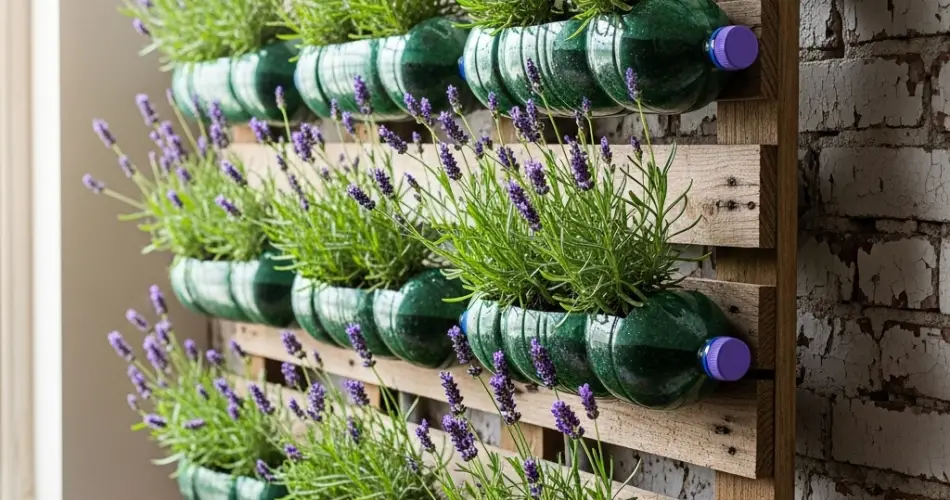Transforming a plain wall into a vibrant, aromatic garden is easier than you might think. By repurposing plastic bottles and planting lavender, you can create a vertical garden that not only saves space but also fills your surroundings with a calming, fragrant scent. This guide will walk you through the process step by step, offering tips for a sustainable, visually appealing, and fragrant garden wall.
Choosing the Right Bottles
The first step in creating a bottle wall garden is selecting your containers. Standard 1- or 2-liter plastic bottles work perfectly for this project. Choose bottles that are clean and free of labels. If you prefer, you can paint or decorate them to add color and personality to your garden. Remember to use bottles made of durable plastic that can withstand outdoor conditions if your wall will be exposed to sunlight and rain.
Preparing the Bottles
Once you have your bottles, it’s time to prepare them for planting. Start by cutting the bottles horizontally or vertically, depending on your design preference. Horizontal cuts create a small trough-like opening, while vertical cuts allow more planting space and a unique staggered look. Ensure the openings are large enough for planting lavender seedlings and allow for water drainage. Poke a few holes in the bottom of each bottle to prevent waterlogging, which can harm the roots.
Selecting Lavender Varieties
Lavender is ideal for vertical gardens due to its compact growth and delightful fragrance. Popular varieties include English lavender (Lavandula angustifolia), French lavender (Lavandula dentata), and Spanish lavender (Lavandula stoechas). Choose a variety that suits your climate and the space available. English lavender, for example, is known for its sweet scent and dense growth, making it perfect for a fragrant wall garden.
Planting Lavender
Fill the prepared bottles with a well-draining potting mix, ideally a blend designed for Mediterranean herbs. Lavender thrives in soil that is not overly rich in nutrients, so avoid using heavy compost or garden soil alone. Plant the lavender seedlings gently, ensuring the roots are fully covered with soil and the plant is secure. Water the plants lightly to help them settle into their new homes.
Designing Your Wall Layout
The arrangement of your bottle garden will affect both aesthetics and plant health. Consider a staggered or grid pattern to ensure each plant receives adequate sunlight. If your wall is exposed to strong winds, place the bottles closer together to provide some protection for the lavender stems. You can also create patterns or color variations by painting bottles in soft pastel shades or leaving them clear for a more natural look.
Mounting the Bottles
There are several ways to attach bottles to a wall safely. Use sturdy hooks, brackets, or wire mesh to secure the bottles in place. Make sure each bottle is anchored well to avoid tipping or falling. For outdoor walls, consider using corrosion-resistant screws or ties. If your wall is indoors, lightweight adhesive hooks or wall-mounted racks may suffice. Ensure the bottles are angled slightly forward to allow excess water to drain freely.
Caring for Your Lavender Wall
Maintaining a vertical lavender garden requires regular care. Lavender prefers full sun, so ensure your wall receives at least six hours of direct sunlight daily. Water sparingly but consistently, allowing the soil to dry slightly between watering sessions. Avoid overwatering, as this can cause root rot. Fertilize lightly in spring with a balanced, slow-release fertilizer, or opt for organic options like compost tea to keep your plants healthy without overwhelming them.
Prune your lavender plants regularly to maintain their shape and encourage new growth. Remove dead or faded flowers to prolong blooming and preserve the plant’s fragrance. With proper care, your lavender wall can continue to bloom year after year, offering beauty and aroma to your space.
Enhancing the Fragrance Experience
A lavender wall garden is not just visually appealing but also a feast for the senses. To maximize fragrance, position the garden near walkways, patios, or seating areas. The gentle breeze will carry the scent throughout your outdoor space, creating a calming, relaxing atmosphere. You can also combine lavender with other aromatic herbs such as rosemary, thyme, or mint to create a multi-sensory garden wall.
Benefits of a Bottle Wall Garden
Beyond aesthetics and fragrance, a vertical bottle garden offers several benefits. It’s a sustainable way to reuse plastic bottles, reducing waste while creating green space in small areas. Vertical gardens also improve air quality and can act as natural insulation for walls, keeping your space cooler in summer. For urban gardeners with limited space, this method allows for a productive and beautiful garden without the need for traditional plots.
By following these steps, you can create a stunning lavender bottle wall garden that combines beauty, fragrance, and sustainability. Whether placed on a balcony, backyard wall, or indoor sunroom, this vertical garden will bring life, scent, and charm to any environment.



